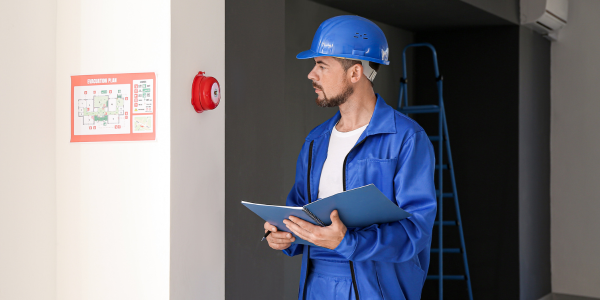Building Safety Regulator Q&A - UPDATE APRIL 2024
Key building information when registering high-rise residential buildings

Building Safety Regulator: Building Assessment Certificates
What is happening on Building Assessment Certificates?
From April 2024, the BSR will start informing PAPs when they need to apply for their building assessment certificate (BAC). HRBs need to be registered with the BSR before this process can start.
What should landlords (AP/PAPs) be doing in preparation for applying for BACs?
Having registered HRBs with the BSR, ‘Accountable Persons’ (APs) and the ‘Principal Accountable Person’ (PAP) need to assess and manage the safety risks in their HRB. This includes preparing the safety case report required for the BAC and developing their resident engagement strategy. They should also begin developing their safety case report to help them manage the risks in each HRB.
Do HRBs need a BAC before they can be occupied?
No. A high-rise residential building does not need a BAC before people can live in it but it will need a BAC once the PAP has been told by the BSR to apply for a BAC. PAPs will have 28 days to submit their applications.
How long after registering a HRB should PAPs expect to wait before applying for BAC?
The length of time between registering the building with BSR and being asked to apply for a BAC depends on the building information supplied at registration. In the first year, the BSR is prioritising buildings that meet at least one of the following criteria, it is:
- over 30 metres to 49.99 metres high with more than 217 residential units
- over 50 metres high with more than 11 residential units
- clad with combustible aluminium composite material
- large panel systems built between 1957 and 1973 with a gas supply, where it is unclear if reinforcement work has been carried out
What information is required for BAC?
PAPs must provide:
- the resident engagement strategy
- information about the mandatory occurrence reporting system
- the safety case report.
BSR will ask PAPs to confirm that they, and any other accountable persons for the building are providing building information to relevant individuals and organisations.
After submitting the BAC application, BSR may ask you:
- to provide additional records or other documents
- for a meeting, either virtual or in person, to discuss parts of your application or the management of building safety risks
- to provide a demonstration of systems used to manage building safety risks, for example maintenance of control measures.
The BSR has published guidance on preparing a BAC application.
Where can I find out more information and get help?
The BSR has published information and guidance on Building safety reforms and Building Control: An overview of the new regime. It has also published information on the roles of APs and the PAP and their legal duties and will be producing case studies. The BSR has published links to recordings of its training webinars, such as:
There are more resources on its website, including webinars. These BSR webinars and training sessions will help Landlords, APs and PAPs understand their legal responsibilities and what the BSR expects. They should consider registering for future sessions, as well as listening to recordings of previous ones.
There is also a free Building Safety Regulator ebulletin for anyone who wants to keep up-to-date and to be alerted on the building safety reforms. It has published its April BSR eBulletin, which gives details of its Conference 2024 on 21 May, which is relevant for Accountable or Principal Accountable Persons, as well as organisations engaged with residents. There will also be sessions for other groups involved in Building Safety.
APs and PAPs should sign up to the BSR eBulletin. These eBulletins also give details of the free webinars the BSR organises to help duty-holders understand their legal responsibilities.
The NHMF Best Practice website has Q&A briefing on the Building Safety Act. Click here to read more.
In addition, the Chartered Association of Building Engineers (CABE) and Building a Safer Future (BSF) have entered a new strategic partnership support organisations assess their competency in relation to building safety, especially in regard to HRBs.
END OF APRIL 2024 UPDATE
______________________________________________________________________________________
Building Safety Act 2022: Duties for Accountable Persons (AP) and Principal Accountable Persons (PAP)
What are the duties for APs and PAPs for existing buildings?
As well as registering ‘in-scope’ high-rise residential buildings with the BSR, ‘Accountable Persons’ (APs) and the ‘Principal Accountable Person’ (PAP) need to assess and manage the safety risks in their high-rise buildings (HRB). These responsibilities include preparing the safety case report required for the Building Assessment Certificate (BAC). Applications will start from April 2024. Each HRB needs to be assessed and will need its own safety case report. These should start by collecting all the important information required to assess and to manage the risks. For existing buildings, APs should research what information they have and then decide how to fill the gaps (largely desktop research). BSR is not expecting costly consultants’ reports but risk assessments will be required for each building and how those risks will be managed. The approach should be based on the principle of proportionality – taking all reasonable steps. The BSR has explained it is not a requirement to bring a HRB up to today’s standards; managing risks effectively is likely to satisfy the legislation. Reports should be based on accurate and up to date information that is held digitally and is transferrable (‘Golden thread’).
Another duty for PAPs is develop their resident engagement strategy. This should be a 2-way process, where PAPs should expect and consider input from residents. It should not be an information dump to the residents. Resident engagement was one of the Government’s key aims after Grenfell - residents’ voices should be heard, and they should be listened to. The strategy should include these four elements – information for residents, questions for them, an explanation of how residents’ opinions will be collected and how to measure and review participation. This strategy should be reviewed every two years.
What is the main focus of the safety case report?
The safety case report should focus on the spread of flame and structural failure. This is the main focus of the Building Safety Act. Risk assessments for each HRB need to consider both aspects and how these risks will be managed. Landlords already have duties in relation to fire safety under the Regulatory Reform (Fire Safety) Order 2005 (FSO), which will include the spread of flame. Under the FSO, they are called the Responsible Person. One person may hold both duties for a HRB and will need to ensure they comply with both the FSO and the Building Safety Act.
What should APs and PAPs be doing after registering their HRBs?
They should begin developing their safety case report to help them manage the risks in each HRB and also their resident engagement strategy. They also need to report every ‘safety occurrence’ (Mandatory occurrence reporting), part of the safety case report for BAC.
When should they apply for BAC?
The BSR will invite applications for BAC from next April 2024. Invitations will be sent out based on the BSR’s risk assessment of each HRB that has been registered. This process is expected will take up to 5 years but APs should be ready to apply when invited. This means building a safety case report now in preparation. While the BSR may not approve BAC applications initially, this does not automatically mean that the HRBs are unsafe. It is more likely that some statutory duties have not been met. APs will be expected to re-submit their applications once the reasons for not being approved have been addressed.
Where can I find out more information and get help?
The BSR has published information and guidance on Building safety reforms and Building Control: An overview of the new regime. It has also published information on the roles of APs and the PAP and their legal duties and will be producing case studies.
There is also a free Building Safety Regulator ebulletin for anyone who wants to keep up-to-date and to be alerted on the building safety reforms. APs and PAPs should sign up to the BSR eBulletin. This eBulletin also gives details of the free webinars the BSR is organising to help duty-holders understand their legal responsibilities and what is expected of them. They are often popular and landlords should consider attending relevant webinars as soon as they can (need to book early because they are often fully-booked) This will help them prepare and assess what external expertise they might require. At one webinar, the BSR explained it does not expect consultants to be used in all cases.
The NHMF Best Practice website has Q&A briefing on the Building Safety Act and the NHMF will be running further webinars on Building Safety in 2024.
In addition, the Chartered Association of Building Engineers (CABE) and Building a Safer Future (BSF) have entered a new strategic partnership support organisations assess their competency in relation to building safety, especially in regard to HRBs.
___________________________________
End of January 2024 update
What key building information do Principal Accountable Persons need to do when registering a high-rise residential building with the Building Safety Regulator?
The principal accountable person (PAP) must provide information about the building’s structure and fire safety (also known as key building information). If there’s more than one structure in the building, this information needs to be provided for each structure.
It should be possible to get the information from the most recent fire risk assessment and any external wall system (EWS) appraisal. It should not be necessary to do a full separate survey.
The key building information will help assessing the building’s risks as part of the safety case.
What key building information will be required?
The BSR has provided detailed guidance on the information it requires but, in summary, it includes the following for residential areas:
- The evacuation strategy
- Fire and smoke control equipment, including heat or smoke detectors, and sprinklers or misters
- The certified fire resistance of your fire doors
- The building’s structure
- Types of energy storage for the building, like lithium ion or hydrogen batteries
- Energy generated on site
- Types of energy supply
- Roof construction and insulation
- All staircases
Where can I find out more information?
The Building Safety Regulator is running a campaign that includes a video on registering high-rise residential buildings.
The BSR also publishes a free BSR eBulletin that gives regular updates and alerts on the building safety reforms. Landlords should sign up to the BSR eBulletin.
The NHMF Best Practice website has Q&A briefing on the Building Safety Act and the NHMF will be running further webinars on Building Safety in 2023.


